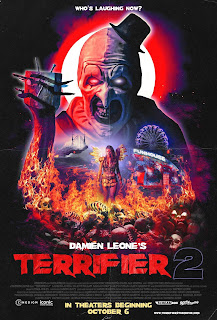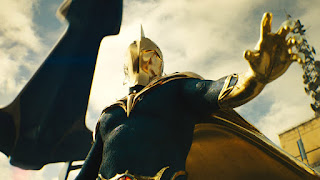The key lines of dialogue in the original Halloween come early on as Laurie Strode sits in school while her off-camera teacher discusses the concept of fate with the class. We hear Laurie's teacher saying "You see, fate caught up with several lives here. No matter what course of action Collins took, he was destined to his own fate, his own day of reckoning with himself." While her teacher is speaking these lines, Laurie is dreamily gazing out the classroom window and catches her first glimpse of Michael Myers standing across the street outside the school. She doesn't realize it yet but fate has arrived and is waiting for her.
As much as Carpenter's original set the template for scores of slasher films to follow, it was also a rumination on the role that fate plays in our lives. Fittingly, Halloween Ends brings the franchise full circle back to that same theme. As in Halloween, fate catches up with several lives here. Many characters in Halloween Ends are marked for tragedy by circumstances outside of their control, in ways that seem to be predestined.
Right from the start, fate intervenes to determine the course of events. Twenty one year old Corey Cunningham (Rohan Campbell) finds himself babysitting the young son of a couple that he's done yard work for only because their regular babysitter had to cancel at the last minute after suddenly contracting a stomach virus. The mother's first words to Corey - and the first lines of dialogue in the film - are "Corey, you're a lifesaver." By the end of the night, the couple's son will be dead due to an accidental fall and Corey will become a pariah in Haddonfield.
Years later, Laurie has a chance encounter with Corey outside a convenience store as he's being harassed by a group of high schoolers and, with Corey's hand bleeding from a deep cut caused by shattered glass, she decides to bring him into the hospital where her granddaughter Allyson (Andi Matichak) works, thinking that Allyson might take a liking to him. She does and later in the film, Allyson reveals to Corey how when she heard about Corey's tragic babysitting incident in the news, she felt that she understood him and that she knew him and she felt that one day he would somehow come into her life. Circumstances have brought them together just as Allyson believed was meant to happen and the question is "were these events random or were they fate?" Do we ever know the forces that shape our lives?
Once Laurie senses Michael's darkness in Corey, she tries to put a stop to his relationship with Allyson but Corey angrily shouts at Laurie "You invited me!" On one level, this is Corey reminding Laurie that he's only in Allyson's life because Laurie brought them together. On another level, it seems to call back to the original Halloween. Did Laurie somehow unwittingly, wordlessly invite Michael into her life and into the lives of her friends back in 1978? Is this fate coming back around as Laurie invites Michael into her life again? Is it also possible that whatever part of Michael that has burrowed its way into Corey is also speaking through Corey in this moment?
On a second viewing of Ends, when we now notice that the tower was present from the very beginning of his relationship with Allyson, it emerges as a symbol of how Corey's fate was always unavoidable, a set point in his future. Even in this hopeful moment where he's talking to a girl who might change his life for the better, that tower and the dark future it represents is standing there like a sentinel or like a pin that's been pushed into a map. It is a reminder that fate will not budge and that Corey's appointed hour will come. No matter what course of action Corey takes, he is destined to his own fate, his own day of reckoning with himself. When Corey sets the tower ablaze during his Halloween rampage, fate has been fulfilled.
Seemingly trivial details in Ends play their part in putting everything in its place. Allyson has a loose muffler on her car but this minor repair remains left undone. When she arrives at the junkyard Corey works at, Allyson tells Corey that she doesn't actually care about getting the car fixed, she just came for him and their relationship starts to move forward. We quickly forget all about the muffler but ultimately it's the sound of that familiar rattle that alerts Corey to Allyson's arrival outside of Laurie home later in the film, giving him the opportunity to make a desperate move. Nothing happens by chance in Ends. In a nod to this, Lindsey Wallace (Kyle Richards), the girl that Laurie once babysat, gives tarot readings, underlining the movie's belief in the unseen forces that guide our lives.
The lives of Ends' characters are intertwined in ways that they are helpless to alter or avoid. Corey and Allyson, the band kids that continually torment Corey, Laurie and Corey and Michael. All of them fated to intersect, all of them fated to instigate life or death choices in the others.
Corey's bullying by the marching band kids draws Laurie to Corey, which brings Corey to Allyson and a second encounter with those kids who refuse to leave Corey alone (because the group's leader is bullied by his father and he wants to inflict the same pain he feels at home onto someone else) brings Corey into contact with Michael, which leads to Corey becoming infected by Michael's darkness. At every turn in Ends, fate tightens its noose. When Corey confronts Laurie in her house at the end and she shoots him, Corey is sent tumbling over the second floor stair railing to the floor below in the exact same manner that the boy he was babysitting had fallen, mirroring the death that had changed the course of Corey's life.
In the end, Michael faces his own fate. He follows Corey to Laurie's house not because he is in pursuit of Laurie but because he is out to retrieve the mask that Corey stole from him, the mask that served as his identity since he first donned it in 1978. Had Michael not been driven to get it back, he wouldn't have crossed paths with Laurie for one final encounter. Fate catches up with Michael in Ends because, like everyone else, he is helpless to avoid it. It's been hardwired into him.
The same impulse that compels Michael to take back his mask is the same that forced him in 1978 to pause his attack on Laurie because his mask had been removed. That mask defined him and, in the end, it's his fixation on it that dooms him. Michael also closes fate's circle by ending Corey's life here. Corey inflicts a potentially fatal wound on himself but we have to wonder if he only did so because he believed that whatever dark essence he was drawing from Michael would allow him to survive it. When Michael arrives to reclaim his mask, though, and Corey jerks to life, Michael ends him on the spot. If not for that, Corey might have continued to carry on as Haddonfield's new boogeyman but with his death at Michael's hands, that possibility is extinguished. With Michael's subsequent death, fate is tied up in a neat bow.
David Gordon Green and his collaborators on Ends (and on the rest of the new Halloween trilogy) have given much thought to the themes of Carpenter's Halloween and that makes Ends a much more fitting finale than some have recognized it to be. This is the first Halloween since the original to acknowledge the deeper underpinnings of fate that are key to Carpenter's film. A movie devoted to yet another battle between Michael and Laurie would not have been as appropriate a tribute to the original as this is. In Ends, it's not just that girl who once stared out of a classroom window unaware of how her life was about to change who finally comes to terms with fate, it's the entire community of Haddonfield that faces a reckoning.






















































